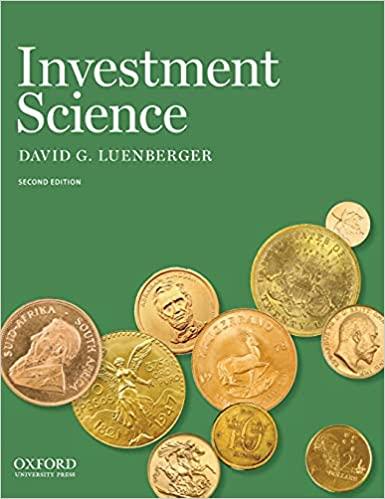The value of a firm is the maximum present value of its possible cash flow streams. This
Question:
The value of a firm is the maximum present value of its possible cash flow streams. This can be expressed as
\[ V_{0}=\max \left[x_{0}+\frac{x_{1}}{1+s_{1}}+\frac{x_{2}}{\left(1+s_{2}\right)^{2}}+\cdots+\frac{x_{n}}{\left(1+s_{n}\right)^{n}}\right], \]
where the maximization is with respect to all possible sfreams $x_{0}, x_{1}, \ldots, x_{n}$, and the $s_{j}$ 's are the spot rates. Let $x_{0}^{*}$ be the first cash flow in the optimal plan. If the firm chooses an arbitrary plan that results in an initial cash flow of $x_{0}$ (distributed to the owners), the value of the firm after 1 year is
\[ V_{1}\left(x_{0}\right)=\max \left\{x_{1}+\frac{x_{2}}{1+s_{1}^{\prime}}+\frac{x_{3}}{\left(1+s_{2}^{\prime}\right)^{2}}+\cdots+\frac{x_{n}}{\left(1+s_{n}^{\prime}\right)^{n-1}}\right\} \]
where now that maximum is with respect to all feasible cash flows that start with $x_{0}$ and the $s_{i}^{\prime}$ 's are the spot rates after 1 year. An investor purchasing the firm at its full fair price has initial cash flow $x_{0}-V_{0}$ and achieves a value of $V_{1}\left(x_{0}\right)$ after 1 year. Hence the 1 -year total return to the investor is
\[ R=\frac{V_{1}\left(x_{0}\right)}{V_{0}-x_{0}} \]
The investor would urge that $x_{0}$ be chosen to maximize $R$. Call this value $\bar{x}_{0}$. Assuming that interest rates follow expectation dynamics and that $V_{1}\left(\bar{x}_{0}\right)>0$, show that the maximum $R$ is $1+s_{1}$ and that this return is achieved by the same $x_{0}^{*}$ that determines $V_{0}$.
Step by Step Answer:






